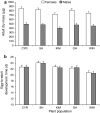Tri-trophic effects of inter- and intra-population variation in defence chemistry of wild cabbage (Brassica oleracea)
- PMID: 21140168
- PMCID: PMC3094535
- DOI: 10.1007/s00442-010-1861-4
Tri-trophic effects of inter- and intra-population variation in defence chemistry of wild cabbage (Brassica oleracea)
Abstract
The effect of direct chemical defences in plants on the performance of insect herbivores and their natural enemies has received increasing attention over the past 10 years. However, much less is known about the scale at which this variation is generated and maintained, both within and across populations of the same plant species. This study compares growth and development of the large cabbage butterfly, Pieris brassicae, and its gregarious pupal parasitoid, Pteromalus puparum, on three wild populations [Kimmeridge (KIM), Old Harry (OH) and Winspit (WIN)] and two cultivars [Stonehead (ST), and Cyrus (CYR)] of cabbage, Brassica oleracea. The wild populations originate from the coast of Dorset, UK, but grow in close proximity with one another. Insect performance and chemical profiles were made from every plant used in the experiment. Foliar glucosinolates (GS) concentrations were highest in the wild plants in rank order WIN > OH > KIM, with lower levels found in the cultivars. Caterpillar-damaged leaves in the wild cabbages also had higher GS levels than undamaged leaves. Pupal mass in P. brassicae varied significantly among populations of B. oleracea. Moreover, development time in the host and parasitoid were correlated, even though these stages are temporally separated. Parasitoid adult dry mass closely approximated the development of its host. Multivariate statistics revealed a correlation between pupal mass and development time of P. brassicae and foliar GS chemistry, of which levels of neoglucobrassicin appeared to be the most important. Our results show that there is considerable variation in quantitative aspects of defensive chemistry in wild cabbage plants that is maintained at very small spatial scales in nature. Moreover, the performance of the herbivore and its parasitoid were both affected by differences in plant quality.
Figures




Similar articles
-
Population-related variation in plant defense more strongly affects survival of an herbivore than its solitary parasitoid wasp.J Chem Ecol. 2011 Oct;37(10):1081-90. doi: 10.1007/s10886-011-0024-3. Epub 2011 Oct 11. J Chem Ecol. 2011. PMID: 21987026 Free PMC article.
-
Development of an insect herbivore and its pupal parasitoid reflect differences in direct plant defense.J Chem Ecol. 2007 Aug;33(8):1556-69. doi: 10.1007/s10886-007-9323-0. Epub 2007 Jun 21. J Chem Ecol. 2007. PMID: 17587139
-
Performance of generalist and specialist herbivores and their endoparasitoids differs on cultivated and wild Brassica populations.J Chem Ecol. 2008 Feb;34(2):132-43. doi: 10.1007/s10886-008-9429-z. Epub 2008 Jan 30. J Chem Ecol. 2008. PMID: 18231835 Free PMC article.
-
Leaf Colour as a Signal of Chemical Defence to Insect Herbivores in Wild Cabbage (Brassica oleracea).PLoS One. 2015 Sep 9;10(9):e0136884. doi: 10.1371/journal.pone.0136884. eCollection 2015. PLoS One. 2015. PMID: 26353086 Free PMC article.
-
Chemosensory detection of glucosinolates as token stimuli for specialist insects on brassicaceous plants: discovery and impact.J Comp Physiol A Neuroethol Sens Neural Behav Physiol. 2024 Mar;210(2):243-248. doi: 10.1007/s00359-023-01684-0. Epub 2023 Dec 20. J Comp Physiol A Neuroethol Sens Neural Behav Physiol. 2024. PMID: 38114856 Review.
Cited by
-
Can caterpillar density or host-plant quality explain host-plant-related parasitism of a generalist forest caterpillar assemblage?Oecologia. 2013 Nov;173(3):971-83. doi: 10.1007/s00442-013-2658-z. Epub 2013 Apr 26. Oecologia. 2013. PMID: 23620347
-
Transcriptome and Metabolome Analyses of Glucosinolates in Two Broccoli Cultivars Following Jasmonate Treatment for the Induction of Glucosinolate Defense to Trichoplusia ni (Hübner).Int J Mol Sci. 2016 Jul 15;17(7):1135. doi: 10.3390/ijms17071135. Int J Mol Sci. 2016. PMID: 27428958 Free PMC article.
-
Development of a generalist predator, Podisus maculiventris, on glucosinolate sequestering and nonsequestering prey.Naturwissenschaften. 2014 Sep;101(9):707-14. doi: 10.1007/s00114-014-1207-x. Epub 2014 Jul 10. Naturwissenschaften. 2014. PMID: 25008387
-
Induced Plant Defenses Against Herbivory in Cultivated and Wild Tomato.J Chem Ecol. 2019 Aug;45(8):693-707. doi: 10.1007/s10886-019-01090-4. Epub 2019 Aug 1. J Chem Ecol. 2019. PMID: 31367970
-
Population-related variation in plant defense more strongly affects survival of an herbivore than its solitary parasitoid wasp.J Chem Ecol. 2011 Oct;37(10):1081-90. doi: 10.1007/s10886-011-0024-3. Epub 2011 Oct 11. J Chem Ecol. 2011. PMID: 21987026 Free PMC article.
References
-
- Agrawal AA. Induced plant defense: evolution of induction and adaptive phenotypic plasticity. In: Agrawal AA, Tuzun S, Bent E, editors. Induced plant defenses against pathogens and herbivores: biochemistry, ecology and agriculture. Minosota: APS; 1999. pp. 251–268.
-
- Askew RR, Shaw MR. Parasitoid communities: their size, structure, and development. In: Waage J, Greathead D, editors. Insect parasitoids. London: Academic; 1986. pp. 225–264.
-
- Barbosa P, Saunders JA, Kemper J, Trumbule R, Olechno J, Martinat P. Plant allelochemicals and insect parasitoids: effects of nicotine on Cotesia congregata (Say) (Hymenoptera, Braconidae) and Hyposoter annulipes (Cresson) (Hymenoptera, Ichneumonidae) J Chem Ecol. 1986;12:1319–1328. doi: 10.1007/BF01012351. - DOI - PubMed
-
- Barbosa P, Gross P, Kemper J. Influence of plant allelochemicals on the tobacco hornworm and its parasitoid, Cotesia congregata. Ecology. 1991;72:1567–1575. doi: 10.2307/1940956. - DOI
Publication types
MeSH terms
Substances
LinkOut - more resources
Full Text Sources
Miscellaneous

